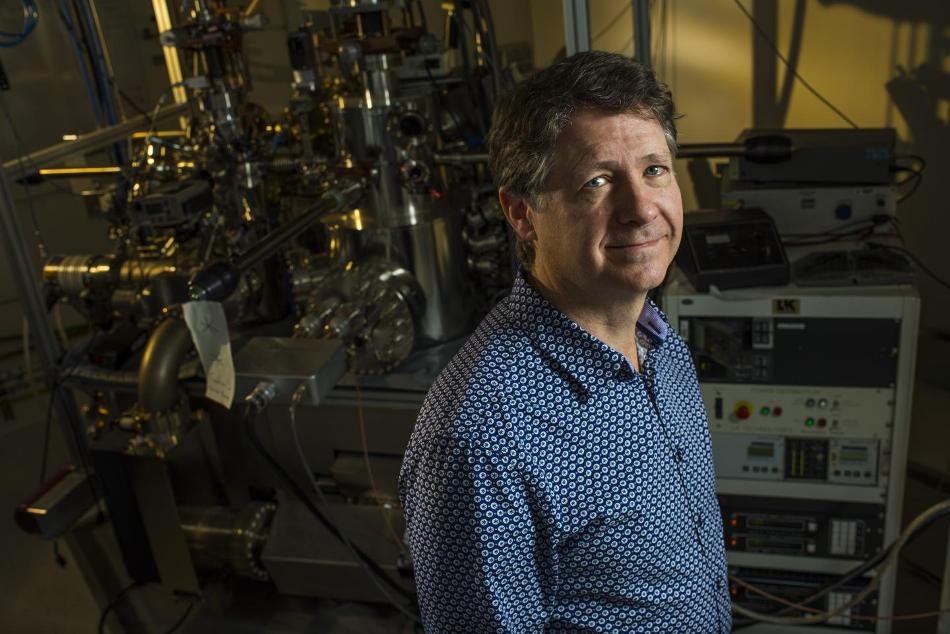Oct 31 2016
 Robert Wolkow, University of Alberta physics professor and the Principal Research Officer at Canada's National Institute for Nanotechnology, has developed a technique to switch a single-atom channel. Credit: John Ulan
Robert Wolkow, University of Alberta physics professor and the Principal Research Officer at Canada's National Institute for Nanotechnology, has developed a technique to switch a single-atom channel. Credit: John Ulan
Robert Wolkow, a pioneer in atomic-scale science with a Guinness World Record for a needle with a single atom at the point, is no stranger to the ultra-fast and ultra-small. Recently, a team headed by Wolkow worked in partnership with collaborators at the Max Plank Institute in Hamburg to develop atomic switches for electricity. These switches are several times smaller than those currently used.
What does it all mean? With the availability of applications for practical systems such as silicon semi-conductor electronics, it means more energy-conserving, more efficient, smaller computers, as just a single example of the technology revolution that is currently unfolding.
This is the first time anyone's seen a switching of a single-atom channel. You've heard of a transistor--a switch for electricity--well, our switches are almost a hundred times smaller than the smallest on the market today.
Robert Wolkow, Physics Professor, University of Alberta
Wolkow is the Principal Research Officer at Canada's National Institute for Nanotechnology.
The tiniest transistors that are currently used work at the 14 nanometer level, which represent thousands of atoms. Wolkow's and his team at the University of Alberta, NINT, and his spinoff QSi, have modified this technology down to just a few atoms. As computers are a composition of a number of on/off switches, the results highlight the way to ultra-efficient general purpose computing and also open new avenues for quantum computing.
We're using this technology to make ultra-green, energy-conserving general purpose computers but also to further the development of quantum computers. We are building the most energy conserving electronics ever, consuming about a thousand times less power than today's electronics.
Robert Wolkow, Physics Professor, University of Alberta
The potential societal, environmental, and economic impact of Wolkow's discovery is extremely large even though the new tech is small. Electronics consume an increased percentage of the electricity available in the world. Material and energy conservation is gaining significance based on the increase in the size of the energy footprint of the digital economy.
Wolkow states that there are surprising advantages to being smaller, both for quantum computers and normal computers. "Quantum systems are characterized by their delicate hold on information. They're ever so easily perturbed. Interestingly though, the smaller the system gets, the fewer upsets." Therefore, Wolkow explains that a system can be developed that is simultaneously small, using less materials and churning through less energy, and at the same time holding onto information just right.
This new technology, once fully developed, will lead to a smaller energy footprint and also more affordable systems for consumers. "It's kind of amazing when everything comes together," says Wolkow.
Wolkow is among the few people in the world discussing atom-scale manufacturing. He believes that individuals are currently witnessing the beginning of the revolution that is yet to come. Wolkow’s team has been working with Lockheed Martin, a large-scale industry leader, as the entry point to the market.
It's something you don't even hear about yet, but atom-scale manufacturing is going to be world-changing. People think it's not quite doable but, but we're already making things out of atoms routinely. We aren't doing it just because. We are doing it because the things we can make have ever more desirable properties. They're not just smaller. They're different and better. This is just the beginning of what will be at least a century of developments in atom-scale manufacturing, and it will be transformational.
Robert Wolkow, Physics Professor, University of Alberta
"Time Resolved Single Dopant Charge Dynamics in Silicon" appeared in the October 26 edition of Nature Communications, an open-access journal in the group of Nature, world-leading scientific publications.